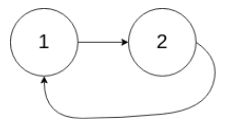- [Python] 数据结构 详解及代码
AIAdvocate
算法python数据结构链表
今日内容大纲介绍数据结构介绍列表链表1.数据结构和算法简介程序大白话翻译,程序=数据结构+算法数据结构指的是存储,组织数据的方式.算法指的是为了解决实际业务问题而思考思路和方法,就叫:算法.2.算法的5大特性介绍算法具有独立性算法是解决问题的思路和方式,最重要的是思维,而不是语言,其(算法)可以通过多种语言进行演绎.5大特性有输入,需要传入1或者多个参数有输出,需要返回1个或者多个结果有穷性,执行
- 数据结构 1
五花肉村长
数据结构算法开发语言c语言visualstudio
1.什么是数据结构数据结构(DataStructure)是计算机存储和组织数据的方式,是指相互之间存在的一种或多种特定关系的数据元的集合。2.什么是算法算法(Algorithm)就是定义良好的计算过程,他取一个或一组的值为输入,并产生出一个或一组值作为输出。简单来说算法就是一系列的计算步骤,用来将输入数据转化成输出结果。3.数据结构和算法的书籍资料学习完数据结构知识,可以去看《剑指offer》和《
- 【数据结构和算法实践-树-LeetCode113-路径总和Ⅱ】
NeVeRMoRE_2024
数据结构与算法实践数据结构算法leetcodeb树
数据结构和算法实践-树-LeetCode113-路径总和Ⅱ题目MyThought代码示例JAVA-8题目给你二叉树的根节点root和一个整数目标和targetSum,找出所有从根节点到叶子节点路径总和等于给定目标和的路径。叶子节点是指没有子节点的节点输入:root=[5,4,8,11,null,13,4,7,2,null,null,5,1],targetSum=22输出:[[5,4,11,2],[
- 互联网 Java 工程师面试题(Java 面试题四)
苹果酱0567
面试题汇总与解析java中间件开发语言springboot后端
下面列出这份Java面试问题列表包含的主题多线程,并发及线程基础数据类型转换的基本原则垃圾回收(GC)Java集合框架数组字符串GOF设计模式SOLID抽象类与接口Java基础,如equals和hashcode泛型与枚举JavaIO与NIO常用网络协议Java中的数据结构和算法正则表达式JVM底层Java最佳实JDBCDate,Time与CalendarJava处理XMLJUnit编程现在是时候给
- 【数据结构和算法实践-树-LeetCode110-平衡二叉树】
NeVeRMoRE_2024
数据结构与算法实践算法数据结构leetcodeb树
数据结构和算法实践-树-LeetCode110-平衡二叉树题目MyThought代码示例JAVA-8题目给定一个二叉树,判断它是否是平衡二叉树输入:root=[3,9,20,null,null,15,7]输出:trueMyThought判断平衡二叉树的条件是树的左右高度相差为1一、利用递归去遍历1、边界为节点为null,树高为0;2、树高的递增规则为,根的左节点和右节点比较值+1二、为了方便信息传
- 海量数据查找最大K个值:数据结构与算法的选择
星辰@Sea
数据结构Java数据结构
在处理大数据集时,经常需要找到数据集中最大的K个元素,这样的需求在很多领域都有广泛应用,例如推荐系统中寻找评分最高的K个商品、数据分析中找出最重要的K个特征、搜索引擎中找到排名前K的结果等等。面对海量数据,传统的排序方法可能不再适用,因为它们通常具有较高的时间复杂度。因此,选择合适的数据结构和算法对于提高效率至关重要。本文将详细介绍如何在海量数据集中查找最大的K个值,探讨不同的数据结构与算法选择,
- 从0开始的算法(数据结构和算法)基础(九)
Solidao
算法数据结构java
二分查找二分查找是一个常规的搜索算法,根据数据的有序性来的。二分查找步骤0.排序,一定要排序,不然这个算法实现不了,可以去看上一篇的排序。初始化边界:首先确定数组的左边界和右边界。左边界一般初始化为0,右边界初始化为数组的长度减1(数组是从0开始的,不要告诉我开始学数据结构的你不知道,array.length-1)。进入循环查找:在左边界小于等于右边界的条件下,继续执行查找操作。计算中间点:每次循
- Java 学习路线:适合小白的超细学习路线及实例代码
Dreams°123
后端javaeclipsejvmspringtomcatideintellij-idea
Java学习路线:适合小白的超细学习路线及实例代码一、入门基础1.1、Java基础语法1.2、面向对象编程(OOP)二、核心Java编程2.1、数据结构和算法基础2.2、输入输出(I/O)三、进阶Java编程3.1、多线程编程3.2、网络编程四、高级应用4.1、数据库编程4.2、Web开发4.3、框架与库五、实践项目与进阶学习(留作业啦)5.1、实践项目5.2、持续学习一、入门基础1.1、Java
- 【数据结构和算法实践-树-LeetCode107-二叉树的层序遍历Ⅱ】
NeVeRMoRE_2024
数据结构与算法实践数据结构算法leetcode
数据结构和算法实践-树-LeetCode107-二叉树的层序遍历Ⅱ题目MyThought代码示例JAVA-8题目给你二叉树的根节点root,返回其节点值自底向上的层序遍历。(即按从叶子节点所在层到根节点所在的层,逐层从左向右遍历)。输入:root=[3,9,20,null,null,15,7]输出:[[15,7],[9,20],[3]]MyThought题目给定的是通过二叉树的层序去遍历,结合示例
- 探索图形算法的奇妙世界:goraph
孔岱怀
探索图形算法的奇妙世界:goraphgoraphPackagegoraphimplementsgraphdatastructureandalgorithms.项目地址:https://gitcode.com/gh_mirrors/go/goraph在编程领域,数据结构和算法是构建高效应用的基础。今天,我们要向您推荐一款名为【goraph】的开源项目,它是一个用Go语言实现的图形数据结构及其算法库。
- 【Lidar】基于Python的点云数据下采样+体素显示
RS迷途小书童
激光雷达点云数据python开发语言激光点云数据点云数据处理
1Open3D库介绍Open3D是一个开源的3D数据处理库,发布于2015年,目前已经更新到0.17.0版本。它基于MIT协议开源许可,使用C++11实现,并经过高度优化,还通过PythonPybinding提供了前端PythonAPI。Open3D为开发者提供了一组精心选择的数据结构和算法,内部实现高度优化并设置为并行化。它处理3D数据的各种应用,包括点云、网格、体积计算、可视化、深度学习、测量
- 图解数据结构python读书笔记_python cookbook3读书笔记第一章数据结构和算法
eternal?
pythonheapq模块查询一组序列中最大和最小的数据importheapqnums=[1,8,2,23,7,-4,18,23,42,37,]#获取序列中3个最大值#print(heapq.nlargest(3,nums))#获取序列中3个最小值#print(heapq.nsmallest(3,nums))#把数据压入堆中在堆中最小的那个数值永远排在最前面时间想取出最小的3个数值只需执行3次he
- 从0开始的算法(数据结构和算法)基础(八)
Solidao
算法数据结构排序算法
说了这么久的数据结构,理论性比较强,下面我们来进入算法部分,运用之前学的数据结构来实现算法。今天的主体部分是排序,难度不大。排序排序的算法是比较简单实用的算法,也是很多的算法的基础。也分很多种,可以根据时间空间难度不同的,有序数据能够被更高效地查找、分析和处理。选择排序选择算法是一个时间复杂度O(n2),空间复杂度是O(1),运行时间比较长。其主要思想是每次从未排序的部分中选择最小(或最大)的元素
- 计算机学习
程序员牛马家
java
不要只盯着计算机语言学习,你现在已经学习了C语言和Java,暑假又规划学习Python,最后你掌握的就是计算机语言包而已。2.建议你找一门想要深挖的语言,沿着这个方向继续往后学习知识就行。计算机语言是学不完的,而未来就业找工作要从事技术岗位,需要不仅仅是计算机语言的,还得学习数据结构和算法、操作系统、计算机网络、数据库、还得做实战项目等等。java不敢用ChatGPT水论文了!OpenAI反作弊工
- Java 技术栈:Java 中的 HashSet、LinkedHashSet 和 TreeSet(Set 集合)特点与实现解析
阳爱铭
java技术栈javapython开发语言后端数据库架构数据结构个人开发
Java集合框架(JavaCollectionsFramework)是Java编程语言中处理集合的基础设施,提供了强大的数据结构和算法支持。本文将深入探讨Java中的三种主要Set集合:HashSet、LinkedHashSet和TreeSet,分析它们的特点、实现原理及实际应用场景。1.Set接口概述Set接口是Java集合框架中的一个重要接口,定义了一组不允许重复元素的集合。与List接口不同
- 在Go中理解栈和先进先出原则
jzpfbpx
golang算法开发语言
Go是一种功能强大的编程语言,提供了丰富的数据结构和算法。堆栈是计算机科学中的基本数据结构之一。在本博文中,我们将探讨如何在Go中实现和使用堆栈,以及堆栈如何遵循先进先出(FIFO)原则。首先,让我们来看看堆栈是什么以及它是如何工作的。栈是一种线性数据结构,用于存储元素集合。堆栈的主要特点是遵循后进先出(LIFO)原则:最后一个添加到堆栈的元素是第一个被移除的元素。下面是一个如何在Go中实现简单堆
- 数据结构——单向链表(C语言版)
GG Bond.ฺ
数据结构链表c语言
在数据结构和算法中,链表是一种常见的数据结构,它由一系列节点组成,每个节点包含数据和指向下一个节点的指针。在C语言中,我们可以使用指针来实现单向链表。下面将详细介绍如何用C语言实现单向链表。目录1.定义节点结构体2.初始化链表3.插入节点4.删除节点5.遍历链表6.主函数1.定义节点结构体首先,我们需要定义表示链表节点的结构体。每个节点包含一个数据域和一个指向下一个节点的指针域。typedefst
- 数据结构与算法-希尔排序
时光不老c
数据结构与算法算法java数据结构
引言在计算机科学中,数据结构和算法是构建高效软件系统的基石。而排序算法作为算法领域的重要组成部分,一直在各种应用场景中发挥着关键作用。今天我们将聚焦于一种基于插入排序的改进版本——希尔排序(ShellSort),深入了解其原理、实现步骤以及优缺点。一、希尔排序简介希尔排序(ShellSort)是由DonaldShell在1959年提出的,它是对插入排序的一种改进,通过定义一个增量序列来对原始数据进
- 在Go中理解栈和先进先出原则
ldxxxxll
golang算法开发语言
Go是一种功能强大的编程语言,提供了丰富的数据结构和算法。堆栈是计算机科学中的基本数据结构之一。在本博文中,我们将探讨如何在Go中实现和使用堆栈,以及堆栈如何遵循先进先出(FIFO)原则。首先,让我们来看看堆栈是什么以及它是如何工作的。栈是一种线性数据结构,用于存储元素集合。堆栈的主要特点是遵循后进先出(LIFO)原则:最后一个添加到堆栈的元素是第一个被移除的元素。下面是一个如何在Go中实现简单堆
- 为什么要学习数据结构和算法?
Programmer Liu
数据结构与算法数据结构算法
你是不是觉得数据结构和算法,跟操作系统、计算机网络一样,是脱离实际工作的知识?可能除了面试,这辈子也用不着?尽管计算机相关专业的同学在大学都学过这门课程,甚至很多培训机构也会培训这方面的知识,但是据我了解,很多程序员对数据结构和算法依旧一窍不通。还有一些人也只听说过数组、链表、快排这些最最基本的数据结构和算法,稍微复杂一点的就完全没概念。当然,也有很多人说,自己实际工作中根本用不到数据结构和算法。
- 学习数据结构和算法的第8天
blxx
数据结构学习算法
顺序表的实现进行头插eg:在数组12345的开头插入-1变成-112345#includetypedefstructSeqList{SLDataTypea[100];//假设顺序表最大容量为100intsize;//当前顺序表的大小}SL;voidSeqListPushFront(SL*ps,SLDataTypex){intend=ps->size-1;while(end>=0){ps->a[en
- 1~10
luckyhubo
p1课程内容介绍学习数据结构的重要性线性结构:数组栈队列链表哈希表:树结构:图结构:排序&搜索p2邂逅数据结构和算法p3什么是数据结构数据结构就是在计算机中,存储和组织数据的方式。p4什么是算法
- 11递归---解析案例汉诺塔问题和斐波那契数列
程序媛小菜鸡成长中
数据结构与算法算法java递归算法
前言数据结构和算法的最终目标都是降低时间复杂度。数据结构是从数据组织形式的角度达成这个目标;算法则是从数据处理的角度达成这个目标。1、什么递归通俗解释就是某个函数自己调用自己。递归的两层含义:(1)递归问题必须可以分解为若干个规模较小,与原问题形式相同的子问题,并且这些子问题可以用完全相同的解题思路来解决。(2)递归问题的演化过程是一个对原问题从大到小进行拆解的过程,并且会有一个明确的终点(临界点
- WebSocket | 基于TCP的全双工通信网络协议
逐梦苍穹
JavaEE网络协议websockettcp/ip
文章目录1、介绍2、示例2.1、分析2.2、代码开发2.3、功能测试作者介绍:双非本科大三网络工程专业在读,阿里云专家博主,专注于Java领域学习,擅长web应用开发、数据结构和算法,初步涉猎Python人工智能开发和前端开发。主页:@逐梦苍穹所属专栏:JavaEE✈您的一键三连,是我创作的最大动力1、介绍WebSocket是基于TCP的一种新的网络协议。它实现了浏览器与服务器全双工通信——浏览器
- 手把手教您刷力扣,击破数据结构和算法--笔记
print('冰心')
力扣入门笔记算法数据结构leetcode
强推学习视频:手把手带你刷Leetcode力扣|各个击破数据结构和算法|大厂面试必备技能【已完结】_哔哩哔哩_bilibili「力扣」8.5折优惠链接:https://leetcode-cn.com/premium/?promoChannel=siyangyuan其他相关合集:手把手带你刷力扣+数据结构+算法合集:BV1sy4y1q79MLeetcode力扣1-300题视频讲解合集:BV1xa41
- 手把手教您刷力扣,击破数据结构和算法--笔记(链表)
print('冰心')
力扣入门笔记算法数据结构leetcode
强推学习视频:手把手带你刷Leetcode力扣|各个击破数据结构和算法|大厂面试必备技能【已完结】_哔哩哔哩_bilibili「力扣」8.5折优惠链接:https://leetcode-cn.com/premium/?promoChannel=siyangyuan其他相关合集:手把手带你刷力扣+数据结构+算法合集:BV1sy4y1q79MLeetcode力扣1-300题视频讲解合集:BV1xa41
- 力扣算法Algorithm竞赛模板库(codeforces-go):含了算法竞赛中常用的数据结构和算法实现,助力开发者更高效地解决问题
汀、人工智能
#习题_算法算法leetcode数据结构动态规划图论力扣算法资料
1.算法Algorithm竞赛模板库(codeforces-go)算法竞赛模板库,为算法竞赛爱好者提供了一系列精心设计的算法模板。这个库包含了算法竞赛中常用的数据结构和算法实现,助力开发者更高效地解决问题一个算法模板应当涵盖以下几点:对该算法的基本介绍(核心思想、复杂度等)参考链接或书籍章节(讲的比较好的资料)模板代码(可以包含一些注释、使用说明)模板补充内容(常见题型中的额外代码、建模技巧等)相
- JS的高级用法
一只理智恩
jsjavascript前端ajaxnode.jsvue.jsreact.jses6
关于JS高级用法在学习JavaScript的过程中,我们必须了解一些基础知识,如变量、函数、类、循环等。这些基础知识是我们使用JavaScript的基础。但是,在日常的业务开发中,我们需要一些更高级的技巧来更好地解决问题。通过阅读本文,你将了解到JS的高级知识点以及实际应用技巧,如高级数据结构和算法、函数式编程、异步编程和面向对象编程。我们会利用代码实例来让大家更好地理解这些知识点。同时,我们也会
- 【leetcode刷题之路】面试经典150题(1)——数组/字符串
小天才才
#力扣#字符串leetcode面试算法
文章目录1数组/字符串1.1【排序】合并两个有序数组1.2【双指针】移除元素1.3【双指针】删除有序数组中的重复项1.4【双指针】删除有序数组中的重复项II1.5【数学】多数元素1.6【数组】轮转数组1.7【动态规划】买卖股票的最佳时机1.8【贪心】买卖股票的最佳时机II1.9【贪心】【动态规划】跳跃游戏1.10【贪心】【动态规划】跳跃游戏II1.11【二分】H指数1.12【模拟】时间插入、删除和
- 【leetcode刷题之路】面试经典150题(2)——双指针+滑动窗口+矩阵
小天才才
#力扣leetcode面试矩阵算法
文章目录2双指针2.1【双指针】验证回文串2.2【双指针】判断子序列2.3【双指针】两数之和II-输入有序数组2.4【双指针】盛最多水的容器2.5【双指针】三数之和3滑动窗口3.1【双指针】长度最小的子数组3.2【滑动窗口】无重复字符的最长子串3.3【哈希表】串联所有单词的子串3.4【哈希表】最小覆盖子串4矩阵4.1【哈希表】有效的数独4.2【模拟】螺旋矩阵4.3【数学】旋转图像4.4【哈希】矩阵
- 强大的销售团队背后 竟然是大数据分析的身影
蓝儿唯美
数据分析
Mark Roberge是HubSpot的首席财务官,在招聘销售职位时使用了大量数据分析。但是科技并没有挤走直觉。
大家都知道数理学家实际上已经渗透到了各行各业。这些热衷数据的人们通过处理数据理解商业流程的各个方面,以重组弱点,增强优势。
Mark Roberge是美国HubSpot公司的首席财务官,HubSpot公司在构架集客营销现象方面出过一份力——因此他也是一位数理学家。他使用数据分析
- Haproxy+Keepalived高可用双机单活
bylijinnan
负载均衡keepalivedhaproxy高可用
我们的应用MyApp不支持集群,但要求双机单活(两台机器:master和slave):
1.正常情况下,只有master启动MyApp并提供服务
2.当master发生故障时,slave自动启动本机的MyApp,同时虚拟IP漂移至slave,保持对外提供服务的IP和端口不变
F5据说也能满足上面的需求,但F5的通常用法都是双机双活,单活的话还没研究过
服务器资源
10.7
- eclipse编辑器中文乱码问题解决
0624chenhong
eclipse乱码
使用Eclipse编辑文件经常出现中文乱码或者文件中有中文不能保存的问题,Eclipse提供了灵活的设置文件编码格式的选项,我们可以通过设置编码 格式解决乱码问题。在Eclipse可以从几个层面设置编码格式:Workspace、Project、Content Type、File
本文以Eclipse 3.3(英文)为例加以说明:
1. 设置Workspace的编码格式:
Windows-&g
- 基础篇--resources资源
不懂事的小屁孩
android
最近一直在做java开发,偶尔敲点android代码,突然发现有些基础给忘记了,今天用半天时间温顾一下resources的资源。
String.xml 字符串资源 涉及国际化问题
http://www.2cto.com/kf/201302/190394.html
string-array
- 接上篇补上window平台自动上传证书文件的批处理问卷
酷的飞上天空
window
@echo off
: host=服务器证书域名或ip,需要和部署时服务器的域名或ip一致 ou=公司名称, o=公司名称
set host=localhost
set ou=localhost
set o=localhost
set password=123456
set validity=3650
set salias=s
- 企业物联网大潮涌动:如何做好准备?
蓝儿唯美
企业
物联网的可能性也许是无限的。要找出架构师可以做好准备的领域然后利用日益连接的世界。
尽管物联网(IoT)还很新,企业架构师现在也应该为一个连接更加紧密的未来做好计划,而不是跟上闸门被打开后的集成挑战。“问题不在于物联网正在进入哪些领域,而是哪些地方物联网没有在企业推进,” Gartner研究总监Mike Walker说。
Gartner预测到2020年物联网设备安装量将达260亿,这些设备在全
- spring学习——数据库(mybatis持久化框架配置)
a-john
mybatis
Spring提供了一组数据访问框架,集成了多种数据访问技术。无论是JDBC,iBATIS(mybatis)还是Hibernate,Spring都能够帮助消除持久化代码中单调枯燥的数据访问逻辑。可以依赖Spring来处理底层的数据访问。
mybatis是一种Spring持久化框架,要使用mybatis,就要做好相应的配置:
1,配置数据源。有很多数据源可以选择,如:DBCP,JDBC,aliba
- Java静态代理、动态代理实例
aijuans
Java静态代理
采用Java代理模式,代理类通过调用委托类对象的方法,来提供特定的服务。委托类需要实现一个业务接口,代理类返回委托类的实例接口对象。
按照代理类的创建时期,可以分为:静态代理和动态代理。
所谓静态代理: 指程序员创建好代理类,编译时直接生成代理类的字节码文件。
所谓动态代理: 在程序运行时,通过反射机制动态生成代理类。
一、静态代理类实例:
1、Serivce.ja
- Struts1与Struts2的12点区别
asia007
Struts1与Struts2
1) 在Action实现类方面的对比:Struts 1要求Action类继承一个抽象基类;Struts 1的一个具体问题是使用抽象类编程而不是接口。Struts 2 Action类可以实现一个Action接口,也可以实现其他接口,使可选和定制的服务成为可能。Struts 2提供一个ActionSupport基类去实现常用的接口。即使Action接口不是必须实现的,只有一个包含execute方法的P
- 初学者要多看看帮助文档 不要用js来写Jquery的代码
百合不是茶
jqueryjs
解析json数据的时候需要将解析的数据写到文本框中, 出现了用js来写Jquery代码的问题;
1, JQuery的赋值 有问题
代码如下: data.username 表示的是: 网易
$("#use
- 经理怎么和员工搞好关系和信任
bijian1013
团队项目管理管理
产品经理应该有坚实的专业基础,这里的基础包括产品方向和产品策略的把握,包括设计,也包括对技术的理解和见识,对运营和市场的敏感,以及良好的沟通和协作能力。换言之,既然是产品经理,整个产品的方方面面都应该能摸得出门道。这也不懂那也不懂,如何让人信服?如何让自己懂?就是不断学习,不仅仅从书本中,更从平时和各种角色的沟通
- 如何为rich:tree不同类型节点设置右键菜单
sunjing
contextMenutreeRichfaces
组合使用target和targetSelector就可以啦,如下: <rich:tree id="ruleTree" value="#{treeAction.ruleTree}" var="node" nodeType="#{node.type}"
selectionChangeListener=&qu
- 【Redis二】Redis2.8.17搭建主从复制环境
bit1129
redis
开始使用Redis2.8.17
Redis第一篇在Redis2.4.5上搭建主从复制环境,对它的主从复制的工作机制,真正的惊呆了。不知道Redis2.8.17的主从复制机制是怎样的,Redis到了2.4.5这个版本,主从复制还做成那样,Impossible is nothing! 本篇把主从复制环境再搭一遍看看效果,这次在Unbuntu上用官方支持的版本。 Ubuntu上安装Red
- JSONObject转换JSON--将Date转换为指定格式
白糖_
JSONObject
项目中,经常会用JSONObject插件将JavaBean或List<JavaBean>转换为JSON格式的字符串,而JavaBean的属性有时候会有java.util.Date这个类型的时间对象,这时JSONObject默认会将Date属性转换成这样的格式:
{"nanos":0,"time":-27076233600000,
- JavaScript语言精粹读书笔记
braveCS
JavaScript
【经典用法】:
//①定义新方法
Function .prototype.method=function(name, func){
this.prototype[name]=func;
return this;
}
//②给Object增加一个create方法,这个方法创建一个使用原对
- 编程之美-找符合条件的整数 用字符串来表示大整数避免溢出
bylijinnan
编程之美
import java.util.LinkedList;
public class FindInteger {
/**
* 编程之美 找符合条件的整数 用字符串来表示大整数避免溢出
* 题目:任意给定一个正整数N,求一个最小的正整数M(M>1),使得N*M的十进制表示形式里只含有1和0
*
* 假设当前正在搜索由0,1组成的K位十进制数
- 读书笔记
chengxuyuancsdn
读书笔记
1、Struts访问资源
2、把静态参数传递给一个动作
3、<result>type属性
4、s:iterator、s:if c:forEach
5、StringBuilder和StringBuffer
6、spring配置拦截器
1、访问资源
(1)通过ServletActionContext对象和实现ServletContextAware,ServletReque
- [通讯与电力]光网城市建设的一些问题
comsci
问题
信号防护的问题,前面已经说过了,这里要说光网交换机与市电保障的关系
我们过去用的ADSL线路,因为是电话线,在小区和街道电力中断的情况下,只要在家里用笔记本电脑+蓄电池,连接ADSL,同样可以上网........
- oracle 空间RESUMABLE
daizj
oracle空间不足RESUMABLE错误挂起
空间RESUMABLE操作 转
Oracle从9i开始引入这个功能,当出现空间不足等相关的错误时,Oracle可以不是马上返回错误信息,并回滚当前的操作,而是将操作挂起,直到挂起时间超过RESUMABLE TIMEOUT,或者空间不足的错误被解决。
这一篇简单介绍空间RESUMABLE的例子。
第一次碰到这个特性是在一次安装9i数据库的过程中,在利用D
- 重构第一次写的线程池
dieslrae
线程池 python
最近没有什么学习欲望,修改之前的线程池的计划一直搁置,这几天比较闲,还是做了一次重构,由之前的2个类拆分为现在的4个类.
1、首先是工作线程类:TaskThread,此类为一个工作线程,用于完成一个工作任务,提供等待(wait),继续(proceed),绑定任务(bindTask)等方法
#!/usr/bin/env python
# -*- coding:utf8 -*-
- C语言学习六指针
dcj3sjt126com
c
初识指针,简单示例程序:
/*
指针就是地址,地址就是指针
地址就是内存单元的编号
指针变量是存放地址的变量
指针和指针变量是两个不同的概念
但是要注意: 通常我们叙述时会把指针变量简称为指针,实际它们含义并不一样
*/
# include <stdio.h>
int main(void)
{
int * p; // p是变量的名字, int *
- yii2 beforeSave afterSave beforeDelete
dcj3sjt126com
delete
public function afterSave($insert, $changedAttributes)
{
parent::afterSave($insert, $changedAttributes);
if($insert) {
//这里是新增数据
} else {
//这里是更新数据
}
}
- timertask
shuizhaosi888
timertask
java.util.Timer timer = new java.util.Timer(true);
// true 说明这个timer以daemon方式运行(优先级低,
// 程序结束timer也自动结束),注意,javax.swing
// 包中也有一个Timer类,如果import中用到swing包,
// 要注意名字的冲突。
TimerTask task = new
- Spring Security(13)——session管理
234390216
sessionSpring Security攻击保护超时
session管理
目录
1.1 检测session超时
1.2 concurrency-control
1.3 session 固定攻击保护
- 公司项目NODEJS实践0.3[ mongo / session ...]
逐行分析JS源代码
mongodbsessionnodejs
http://www.upopen.cn
一、前言
书接上回,我们搭建了WEB服务端路由、模板等功能,完成了register 通过ajax与后端的通信,今天主要完成数据与mongodb的存取,实现注册 / 登录 /
- pojo.vo.po.domain区别
LiaoJuncai
javaVOPOJOjavabeandomain
POJO = "Plain Old Java Object",是MartinFowler等发明的一个术语,用来表示普通的Java对象,不是JavaBean, EntityBean 或者 SessionBean。POJO不但当任何特殊的角色,也不实现任何特殊的Java框架的接口如,EJB, JDBC等等。
即POJO是一个简单的普通的Java对象,它包含业务逻辑
- Windows Error Code
OhMyCC
windows
0 操作成功完成.
1 功能错误.
2 系统找不到指定的文件.
3 系统找不到指定的路径.
4 系统无法打开文件.
5 拒绝访问.
6 句柄无效.
7 存储控制块被损坏.
8 存储空间不足, 无法处理此命令.
9 存储控制块地址无效.
10 环境错误.
11 试图加载格式错误的程序.
12 访问码无效.
13 数据无效.
14 存储器不足, 无法完成此操作.
15 系
- 在storm集群环境下发布Topology
roadrunners
集群stormtopologyspoutbolt
storm的topology设计和开发就略过了。本章主要来说说如何在storm的集群环境中,通过storm的管理命令来发布和管理集群中的topology。
1、打包
打包插件是使用maven提供的maven-shade-plugin,详细见maven-shade-plugin。
<plugin>
<groupId>org.apache.maven.
- 为什么不允许代码里出现“魔数”
tomcat_oracle
java
在一个新项目中,我最先做的事情之一,就是建立使用诸如Checkstyle和Findbugs之类工具的准则。目的是制定一些代码规范,以及避免通过静态代码分析就能够检测到的bug。 迟早会有人给出案例说这样太离谱了。其中的一个案例是Checkstyle的魔数检查。它会对任何没有定义常量就使用的数字字面量给出警告,除了-1、0、1和2。 很多开发者在这个检查方面都有问题,这可以从结果
- zoj 3511 Cake Robbery(线段树)
阿尔萨斯
线段树
题目链接:zoj 3511 Cake Robbery
题目大意:就是有一个N边形的蛋糕,切M刀,从中挑选一块边数最多的,保证没有两条边重叠。
解题思路:有多少个顶点即为有多少条边,所以直接按照切刀切掉点的个数排序,然后用线段树维护剩下的还有哪些点。
#include <cstdio>
#include <cstring>
#include <vector&


